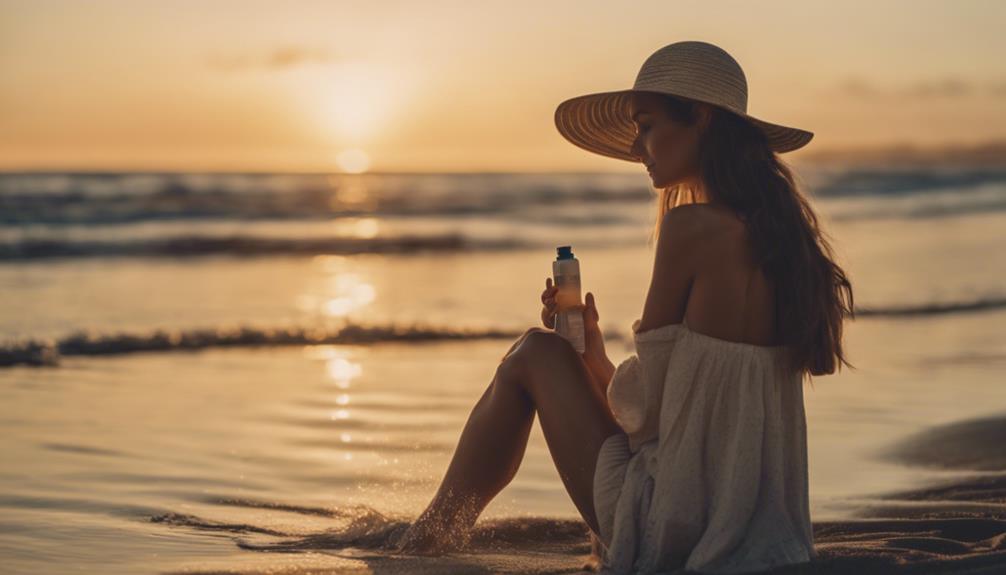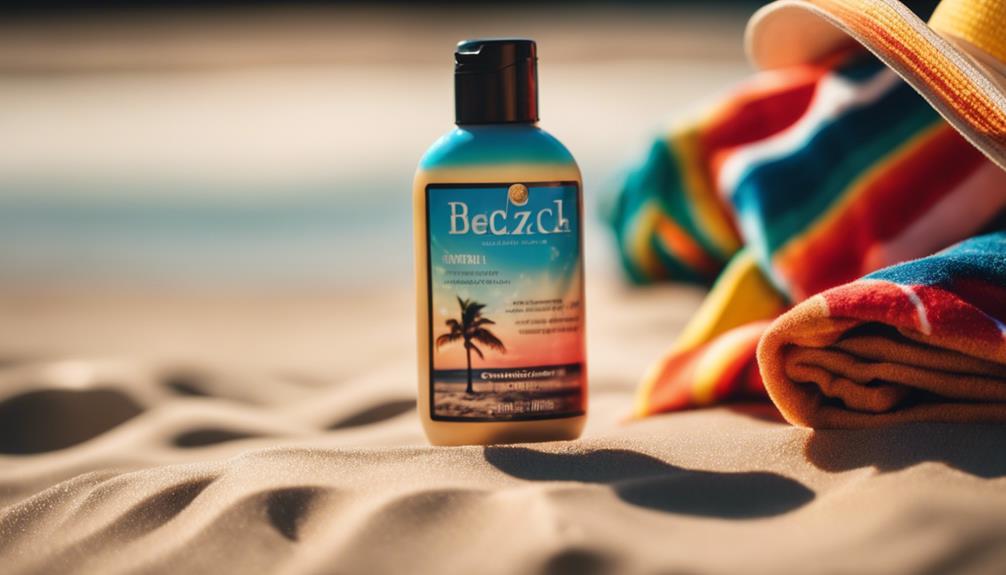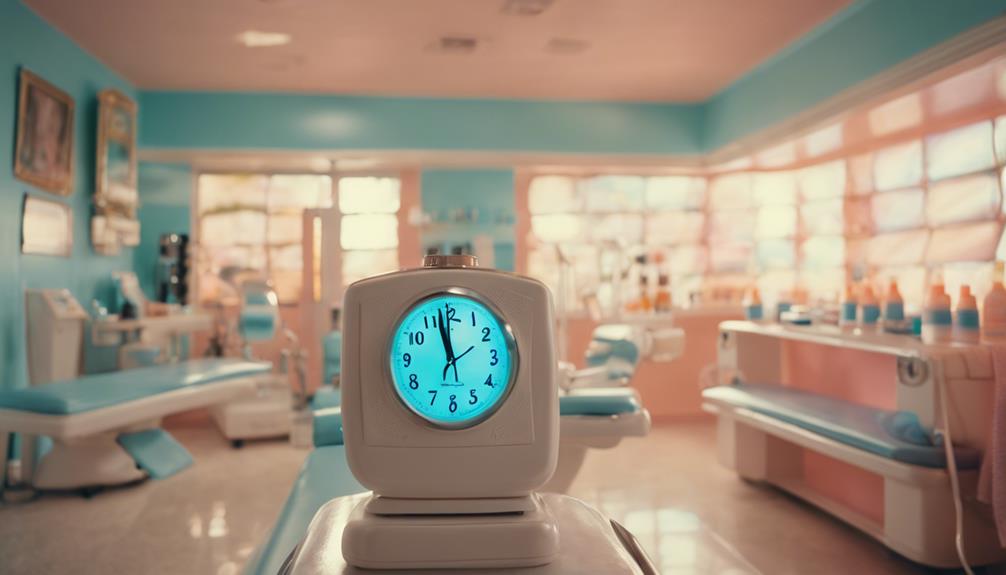Cutting back on tanning is like giving your skin the VIP treatment it deserves! Those tanning beds can be sneaky, raising your chances of skin cancer and speeding up wrinkles. Instead of risking it, why not try self-tanners or airbrush tanning for that sun-kissed glow without the harmful UV rays? Plus, keeping your skin hydrated with moisturizers helps make your tan look even better! Don't forget to check in with a dermatologist for personalized tips on keeping your skin healthy and happy. It's time to swap some tanning habits for healthier choices, and there's more to discover about keeping your skin fabulous!
Key Takeaways
- Reducing tanning bed use lowers the risk of skin cancers, including melanoma, and protects overall skin health.
- Opt for self-tanners or airbrush tanning for a glow without harmful UV exposure.
- Regular skin assessments with a dermatologist help monitor changes and establish a safe tanning routine.
- Prioritize skin hydration with moisturizers and water intake to maintain a healthy appearance.
Health Risks of Tanning Beds
Tanning beds pose serious health risks, greatly increasing your chances of developing skin cancer, including melanoma, basal cell, and squamous cell carcinoma.
You might think a quick session will give you that golden glow, but those concentrated UV rays are way stronger than the midday sun. Imagine that!
Using tanning beds early, especially before age 20, can skyrocket your melanoma risk. Plus, let's face it, who wants wrinkles and sagging skin at a young age?
Overexposure not only damages your skin but also can make existing skin conditions worse.
Safe Tanning Alternatives

For a sun-kissed glow without the risks of UV exposure, consider safe alternatives like self-tanners or airbrush tanning. These options let you achieve that beachy bronze without frying your skin!
Self-tanners come in lotions, sprays, or wipes, and they're super easy to apply—just follow the instructions for a flawless finish. If you want an even more professional look, try airbrush tanning at a salon; it's like having a personal tanning artist!
Don't forget to moisturize before and after tanning to keep your skin happy and hydrated. And hey, while you're at it, grab a bronzer with SPF to protect your skin while still looking fabulous.
Who knew staying safe could look so good?
Tanning Bed Regulations

Regulations surrounding tanning beds are essential for protecting consumers, especially minors, from the heightened risks of skin cancer.
These rules help guarantee that tanning salons operate safely and responsibly. For example, many places have age restrictions that keep kids and teens from using tanning beds, which is a big win for their skin!
The FDA also has guidelines to minimize risks, making certain salons maintain safety standards.
Plus, public health groups work hard to educate everyone about the dangers of tanning.
Pre-Tanning Skin Care

Preparing your skin properly before a tanning session can enhance results and reduce the risk of damage. Think of it like prepping for a big game; you want to be at your best! Start by exfoliating to remove dead skin, then moisturize to keep your skin hydrated. Don't forget to assess your skin for any issues and do a patch test if you're trying a new product. Check out this quick guide to help you out:
| Step | What to Do | Why It's Important |
|---|---|---|
| Exfoliate | Use a gentle scrub or exfoliant | Removes dead skin for even tan |
| Moisturize | Apply a hydrating lotion | Keeps skin soft and smooth |
| Hair Removal | Shave or wax a day before | Prevents irritation during tanning |
| Skin Assessment | Look for any weird spots | Guarantees skin's in good shape |
Now you're ready to glow!
Post-Tanning Skin Care

After tanning, applying a rich moisturizer helps lock in hydration and prolong your sun-kissed glow. You've worked hard for that glow, so don't let it fade away!
Drink plenty of water to keep your skin hydrated from the inside out. Avoid hot showers, since they can strip your skin of moisture faster than you can say “oops!” Stick to mild soap to gently cleanse without causing irritation, and keep exfoliation to a minimum—your skin deserves a break.
Consider adding a soothing aloe vera gel if you feel any redness. By pampering your skin after tanning, you'll help maintain that radiant look, turning heads and maybe even getting a few compliments!
Monitoring Tanning Habits
To maintain healthy tanning habits, track your sessions and set time limits to prevent overexposure. Think of it like keeping score in a game; you want to know how many times you've played to avoid going into overtime! Start by jotting down when and how long you tan. This way, you can see patterns and avoid those tempting extra minutes.
Also, keep an eye on your skin. If you notice any new spots or changes, it's time to reassess. Remember, while a sun-kissed glow feels great, your skin's health is even more important.
Seeking Professional Guidance

Monitoring your tanning habits is important, but seeking professional guidance can take your skin care routine to the next level.
Dermatologists are like your skin's best friends, offering personalized advice based on your unique skin type and tanning history. They can help you understand the risks of tanning and recommend safer alternatives, like self-tanners or airbrush options, so you can achieve that golden glow without the harmful UV exposure.
Plus, they'll help you spot any concerning skin changes, ensuring you catch potential issues early. So, don't hesitate to schedule that appointment!
Your skin will thank you, and you might even leave with some fun tips to keep your skin looking fabulous! It's a win-win!
Frequently Asked Questions
How Can I Recognize Early Signs of Skin Damage From Tanning?
To recognize early signs of skin damage from tanning, watch for changes like dark spots, uneven texture, wrinkles, or new moles. Pay attention to any persistent redness or irritation, and consult a dermatologist if concerned.
What Are the Long-Term Effects of Tanning Bed Use?
Oh sure, who wouldn't want skin like an old leather handbag? Long-term tanning bed use can lead to serious skin damage, premature aging, and a dramatically increased risk of skin cancer. It's just fabulous, right?
Can I Reverse Skin Damage Caused by Tanning?
Yes, you can reverse skin damage from tanning. Start using antioxidants, moisturizers, and retinoids to boost skin repair. Regularly apply sunscreen, stay hydrated, and consider professional treatments for better results. Your skin will thank you!
Are There Any Natural Remedies for Sun-Damaged Skin?
Yes, natural remedies for sun-damaged skin include aloe vera, coconut oil, and vitamin E. These can soothe and hydrate your skin, promoting healing. Always patch test first to avoid irritation and guarantee compatibility with your skin type.
What Is the Safest Way to Achieve a Tan Without UV Exposure?
The safest way to achieve a tan without UV exposure is to use self-tanners or airbrush tanning. These options provide a natural-looking glow while protecting your skin from harmful UV rays and preventing premature aging.
Conclusion
So, why risk your skin's health for a temporary tan when there are safer options out there?
By cutting back on tanning, you're not just saving your skin from wrinkles and damage, you're also embracing a healthier, glowier you! Not only does reducing your tanning habits benefit the appearance of your skin, it also reduces your risk of developing skin cancer. Embracing your natural skin tone can also lead to a boost in self-confidence and self-acceptance. Additionally, researchers are unraveling the science behind tanning itch, which can lead to new insights and treatments for those who struggle with this uncomfortable sensation.
Remember, your skin deserves the best care possible, and with all the fantastic alternatives available, you can shine without the risks.
So, are you ready to ditch the tanning beds and show your skin some love?









